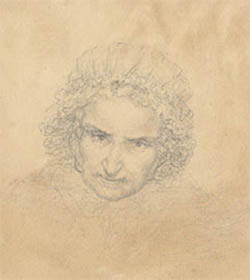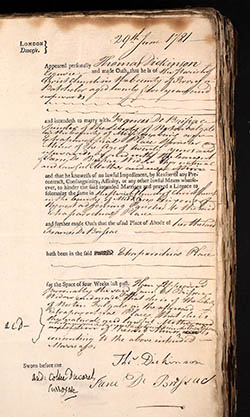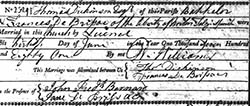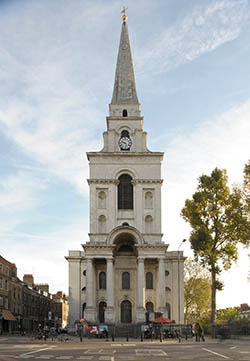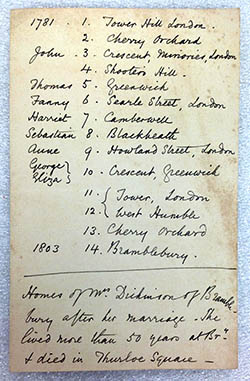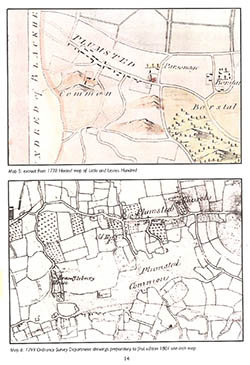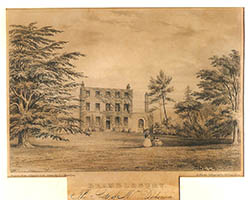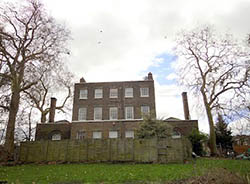Frances DE BRISSAC 1760 - 1854
Fifth child of Peter Abraham de BRISSAC 1731 - 1768 and Jane LOY 1731-1809
Born 22nd September 1760 in Spitalfields, London, England
Died 26th August 1854 in London.
Burial 1 Sep 1854 in Plumstead St Nicholas, Kent
Married Capt. Thomas DICKINSON 1754 - 1828
Frances and Thomas DICKINSON had ten children
Children
1) John DICKINSON 1782 - 1869
m.
Ann GROVER 1789 - 1874
(Seven children.)
2) Thomas DICKINSON 1784 - 1861
m.
1) Catherine DEANE 1786 - 1855
(Eight children.)
2) Mary WEEKES (née MARSHALL) 1812 - 1893
3) Frances DICKINSON 1785 - 1870
4) William DICKINSON 1785 - 1785 (twin of Frances)
Died in infancy.
5) Harriet DICKINSON 1786 - 1865
m.
John Septimus GROVER (Rev) 1766 -1853
6) Sebastian DICKINSON 1787 - 1811
Killed at the siege of Badajos.
7) Anne DICKINSON 1789 - 1789
Died in infancy.
8) Anne DICKINSON 1791 - 1883
m.
Arthur Benoni EVANS 1781-1854
(Six children.)
9) George DICKINSON 1793 - 1843
10) Elizabeth DICKINSON 1795 - 1876
m.
Joseph PHELPS 1791 - 1876
(Eleven children.)
Marriage of Frances de BRISSAC to Thomas DICKINSON
Transcription
LONDON
29th June 1781
Diocese
Appeared personally Thomas Dickinson Esquire and made Oath that he is of the parish of Christ Church in the County of Surrey, a Batchelor (sic) aged twenty five years and upwards
and intendeth to marry with Frances De Brissac a Spinster of the Liberty of Norton Folgate in the County of Middlesex being an Extraparochial Place, Spinster a Minor of the age of twenty years and upwards by and with the Consent of Jane De Brissac Widow her natural and lawful Mother and next of Kin.
and that he knoweth of no lawful Impediment, by Reason of any Pre-contract, Consanguinity, Affinity, or any other lawful Means whatsoever, to hinder the said intended Marriage and prayed a Licence to solemnize the same in the parish Church of Christ Church in the County of Middlesex being one of the next adjoining Parishes to the said Extraparochial Place
and further made Oath that the usual Place of Abode of her the said Frances De Brissac hath been in the said Extraparochial Place for the Space of four Weeks last past.
Then appeared personally the said Jane De Brissac Widow and made Oath that she is of the Liberty of Norton Folgate in the aforesaid Extraparochial Place, that she is the natural and lawful Mother of the said Minor, who having no Testamentary Guardian, she thus Appeared, is consenting to the above intended Marriage.
Thos Dickinson
Jane De Brissac
Sworn before me:
And: Colter(?) Ducarel
Surrogate
Matriarch
Frances was always a devoted wife, mother, grandmother. She is often seen, by her very many descendants, as the matriarch of the family. In her time many members of the family were abroad pursuing varied vocations, military duties and trades. It was to her loving arms they returned to the place called they called ‘home’ at Bramblebury.
Joan Evans on Frances de Brissac.
From: Time and Chance - The story of Arthur Evans and his forebears by Joan Evans Chapter 2 page 17 (Longmans published 1943)
In 1798, the Dickinson family took a cottage in the country for the summer. In a letter from Fanny Burney, Madame d’Arblay the novelist, we read –
“One new acquaintance we have found it impossible to avoid….is now inhabited by a large family from the city, of the name of Dickinson……. Mr Dickinson, or Captain Dickinson, as his name-card says is very shy, but seems a sensible man, and his lady is open, chatty, fond of her children, and anxious to accomplish them. She seems between thirty and forty, and very lively. She is of French origin, though born here, and of parents immediately English; but her grandfather was a M.de Brissac.”
Page 19
Thomas Dickinson’s mother, Alice, had died some years before, and his father had married as his second wife a Mrs Bernard. Both by birth - her maiden name was Lardent - and her first marriage, she belonged to that curious and interesting community of Huguenot refugees that had its centre in Spitalfields. Their forebears had come over from France in the years following the revocation of the Edict of Nantes in 1685; they had become naturalized in England, yet their descendants still formed a foreign community. Through his stepmother Thomas Dickinson found himself admitted to that closed society; a society with the intelligence that accompanies the easy use of two languages, with the piety of a persecuted race, and with the frugal wealth of Frenchmen who are, or have been, dependent upon their own exertions for a living. One of his stepmother’s kinsfolk, John Bernard, a man of his own age, had married a Huguenot lady named Jane de Brissac. Her younger sister, Frances, was still unmarried, and it was she whom Thomas Dickinson took to wife.
… Frances was a woman of unusual energy, with a strong sense of duty, a warm heart, a firm will and sound sense: a fine example, indeed, of the Frenchwoman who loves and manages a large family with firmness, affection and common sense. Her mother had brought he up to appreciate fine silks and delicate laces; she wore with enjoyment her pearl tiara and her parures of bright stones. Though they were not more precious than garnets and amethysts and crystals and liked to wrap herself in an Indian shawl.She was exceedingly proud of her ancestry. She could remember, when she was such a little girl as to have to stand on a
Page 20
footstool to see what was on the table, her grandfather showing her a pedigree which demonstrated to his own satisfaction his connexion with the French ducal house of Cossé Brissac. The grandfather, whose, whose father had escaped from France, had become one of the Spitalfields weavers, and a comparatively wealthy man. His wife, born Jeanne Loy, daughter of a silk weaver of 18 Spital Square, had married as her first husband an Englishman named Nash, by whom she had two sons. This connexion, and the gradual and inevitable Anglicization of all the Huguenot families, helped to bring Peter Abraham de Brissac into a more English world; his sister Anne married an Englishman, William Child, and though his eldest daughter Jane married the Huguenot John Bernard, his other two daughters married Englishmen. (Elizabeth, born 1756, married John Ware; Frances, born 1760, Thomas Dickinson.)
The marriage between Frances de Brissac and Thomas Dickinson, which took place on June 20, 1781, seems to have been a happy one. They complemented one another; he was, in Madame d’Arblay’s words “shy and sensible”; she warm hearted, talkative, an admirable hostess and at bottom, no less sensible than her husband. She bore him four sons and five daughters, one of whom died in infancy. (Joan is wrong - Frances had five sons. Judith.)
Frances lived for more than fifty years at Bramblebury, Plumstead, Kent from 1803 until shortly before her death. However, after her marriage she and Thomas had a number of moves as shown by the list below made by her grandson Sir John Evans.
Bramblebury
Second map shows Bramblebury and countryside towards bottom, left hand side.
Bramblebury from the time of the Dickinsons. In rural Kent and in its own parkland.
Photograph taken in in 2012 by Judith F Hubbard
The house is now made into flats in outer London, surrounded by streets and very little land.
Amazingly original features such as the chimneys are still intact.
From Time and Chance by Joan Evans, Chapter 2 page 21
In 1830 it was decided that Thomas Dickinson should move his headquarters and his home, from Tower Hill to Woolwich. He secured a lease of a pleasant house called Bramblebury from the Cloth-workers’ Company. It had been built some thirty years earlier as a neat three-storied box of a house, with a little pavilion on either side, in an unpretentious yet formal style. It had a good dining-room and library, and a double drawing-room symmetrically disposed on either side of a hall with an open staircase with turned balusters, and any number of decent bedrooms above. It stood on rising ground at the end of a long drive, with a great chestnut at the entrance, and from the drawing-room there was a lovely view, framed in trees, over a Thames gay with sailing ships to the wide skies and low hills beyond. The Garden boasted fine cedars, and gravelled paths wide enough for conversation; there were a couple of meadows, and a neglected and picturesque wood, the joy of children and sketchers.
Judith F Hubbard writes
In my imagination there would have been a good telescope in one of the upstairs bedrooms and from the window it would be possible to pick out the various ships plying up and down the Thames. Capt. Thomas Dickinson being Superintendent of the Ordnance Transports at Woolwich, would have been very familiar with the various sailing vessels frequenting the river.
Death
Death of Frances Dickinson (née de BRISSAC)
Extract from a letter of Fanny Phelps (Frances Phelps 1826 -1890) to her brother Arthur. (Arthur Phelps 1837 - 1920) Transcribed from a scan of the original in November 2013 by Penelope Forret, born Phelps, great granddaughter of Arthur.
A. H. (Abbot’s Hill) 18th September [1854]
I should have written to you last week by Southampton but I was so busy I really hadn't time to tell you of something that will grieve tho' it can't much distress you as it is the news of dear Grandma's death. She died very peacefully & painlessly on the 27th of August. She had refused food for two or three days before, & she had grown so very thin this summer that there was really no flesh left on her bones, & she had nothing to support life with. Aunt Fanny (Frances Dickinson 1785 - 1870) had Anne Evans (Anne Dickinson 1791 -1883) with her, & Mr Douglass the Dr. who had looked after Grandma ever since she has been at Thurloe Square. It was a Sunday so John was at A. H. George came down in the evening with the news. Poor Aunt Fanny was a long time before she could get over it at all, & even now she cries a good deal; poor thing she misses the constant care & attention that she was obliged to give her mother. She & John mean to go on living in the house if they can possibly between them manage to afford it - but she will hardly have £200 a year of her own, & you know that isn't much to keep a house in London, & John is always poor now. However they mean to try & rub on together.
I hope you will write to Aunt Fanny. I am sure she deserves all the little attentions her nephews & nieces can pay her. Grandma was buried in the same vault with her husband at Plumstead on 1st September. I am sorry that there was no Phelps present at the Funeral; the Col, Sib & Willie, my dear old man, & John, Jack Evans & Aunts Fanny & Grover were the only people present.Abbots Hill, Hertfordshire
